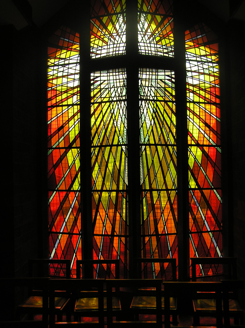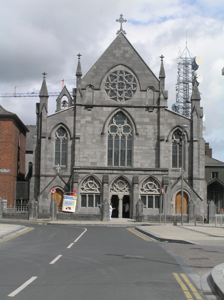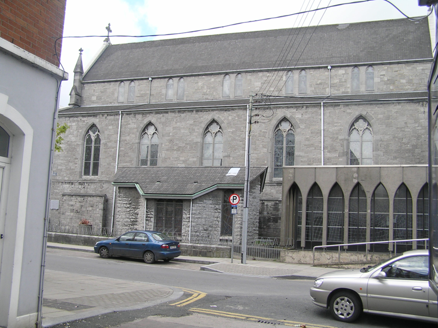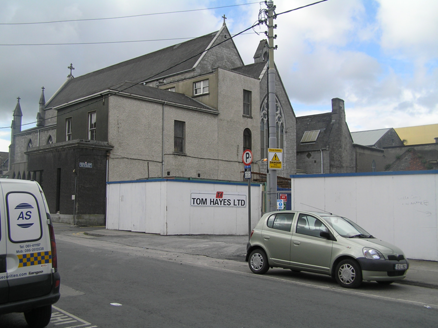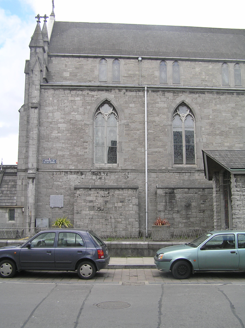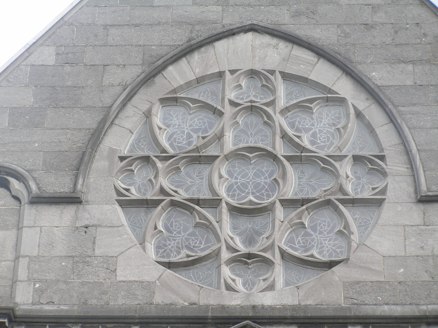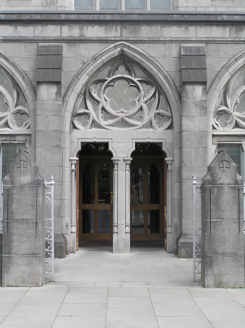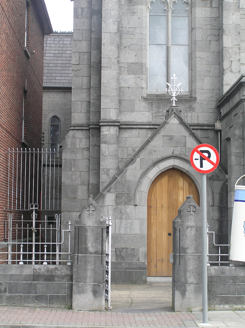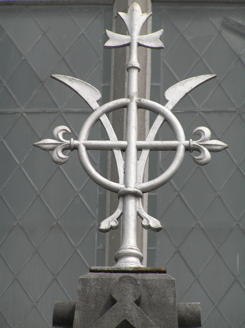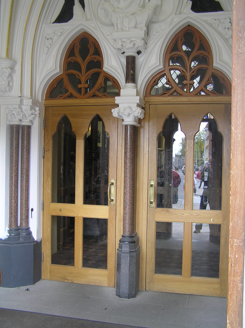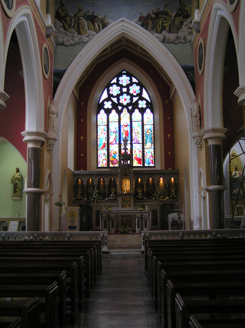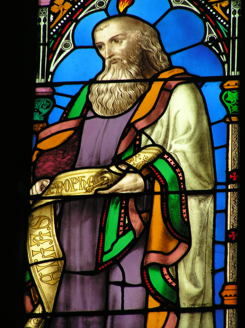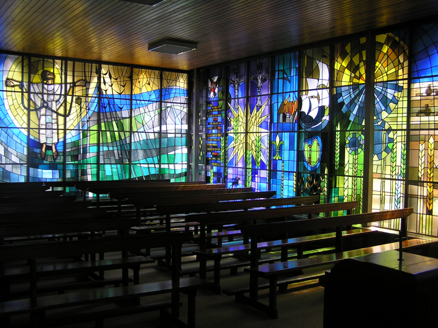Survey Data
Reg No
21518014
Rating
Regional
Categories of Special Interest
Architectural, Artistic, Social
Original Use
Church/chapel
In Use As
Church/chapel
Date
1815 - 1960
Coordinates
157615, 156714
Date Recorded
03/05/2005
Date Updated
--/--/--
Description
Detached rectangular plan ashlar limestone church, dated to 1815, largely reworked to form its current composition, c. 1860-1870, forming a three-storey gabled nave elevation with angle buttresses surmounted by gablet pinnacles rising above, and projecting arcaded narthex, flanked by double-height lean-to aisle elevations with projecting gabled aisle porches, with a gabled east-facing chancel elevation, and five-bay south-facing north and south aisle and clerestorey elevation. Gabled sacristy building attached to northeast and rendered two-storey structure, c. 1890 to southeast. Limestone ashlar belfry to northeast corner, with cast bronze bell. Accretions to south, c. 1960-1970. Single-span gabled manmade tiled roof and lean-to roofs. Double-span gabled roof over chancel and sacristy with flush rock-faced limestone chimneystack, and later roof light to sacristy also. Limestone coping surmounted by limestone cruciform finials to east and west gables parapets with moulded limestone base blocks. Cast-iron, uPVC and stainless steel rainwater goods. Tooled limestone ashlar façade elevation with smooth limestone ashlar dressing. Squared rock-faced limestone to south-facing elevation and east-facing chancel elevation. Cement re-pointing throughout and wholesale cementitious repairs to façade moulding details. West entrance to central pointed-arch opening of narthex flanked by pointed-arch geometric limestone tracery window openings with buttresses to piers. Bipartite square-headed door arrangement with limestone ashlar negative reveals to outer and central jambs, with stop-chamfer detailing and colonnettes. Bull nose moulded limestone ashlar lintels with convex corners. Plank timber doors, original to c. 1860s. Geometric limestone tracery window to tympanum. Plain pointed-arch aisle door openings with hood moulding, flush smooth limestone ashlar surrounds, and double-leaf plank timber doors. Pointed-arch window openings to west-facing and east-facing elevation, c. 1860, with limestone hoodmouldings, and perpendicular tracery. Rose window over nave opening, c. 1860, on west-facing elevation with geometric tracery. To south and north-facing elevations there are pointed-arch aisle openings with limestone ashlar chamfered reveals, flush canted sills and limestone ashlar geometric bar tracery. Paired lancet cusped pointed-arch clerestorey windows with limestone ashlar chamfered reveals and flush sills. Figurative stained glass with lead caming to west, south and east elevation, quarry glass to north elevation and opening flanking principal entrance. Depiction of the Transfiguration, by William Wailes, for the stained glass for the east window, dating to 1866. Figurative leaded stained glass to accretions to south. All window openings fitted with weather glazing. Plastered wall finish to interior with groin-vaulted narthex ceiling springing from polished granite colonnettes on limestone ashlar and plastered bases. Tooled limestone floor slabs, c. 1990. Paired trefoil arched opening with figurative cast plaster figures to tympanum, timber framed glazed doors and overlights, c. 1990, lead to glazed inner porch, c. 1990, under choir and organ gallery. Nave flanked by pointed-arch arcade of polished granite columns with plaster stringcourse and capitals, having plain abacus blocks from which plaster archivolts rise. Painted Gothicised foliated detailing throughout, appears re-painted in more recent times. Plaster medallions to spandrels with figurative mural paintings depicting martyrs and saints. Single pointed-arch leads to raised chancel, enclosed from congregation by marble balustrade. Large mural of transfiguration over altar arch. Gothic Revival marble and polished granite reredos, with centrally-placed pinnacled tabernacle. Three-sided canted choir and organ gallery to west of nave, supported by marbelised cast-iron columns and an elaborate timber pier rising from a limestone base. Notched flat-panelled timber balustrade with punched star motif to plank timber panels. Accessed by cast-iron spiral staircase to north aisle. Timber panelling to aisle walls with carved foliate and Gothicised detailing, incorporating tripartite confessional fronts. One chapel off north aisle dedicated to Sacred Heart, enclosed by wrought-iron and brass balustrade, having raised tiled platform, mosaic tiled walls, plastered groin vaulted ceiling. Altar obscured by scaffolding. To south aisle chapel dedicated to Saint Martin de Porres, dates to 1960. Linoleum floor covering throughout with early encaustic tilework to altar area and nave and aisle area to west. Nineteenth-century timber pews throughout. Corner site enclosed from Baker Place and Dominick Street by limestone plinth wall with steel railings, c. 1960. Square-plan limestone ashlar piers with gablet copings having carved cruciform medallions. Wrought-iron gates, c. 1860s. Slightly raised grounds with slate slab and poured concrete finish. To east faces directly onto Griffith's Row. Detached priory to north on adjacent site, c. 1940-50.
Appraisal
This Gothic Revival Church, though much altered from the earlier Gothic designs of the James Pain, has a strong presence in the area. It was begun for Prior Fr. Joseph Harrigan and consectated 6th July 1816. The repairs and alteration in 1860 were carried out by J.J. McCarthy. The contractor for that work was John Ryan. The architectural composition and carved limestone detailing, which is a composite of Pain's original design and later alterations, most notably that of William Wallace in the 1860s, is testimony to the skill of the architects involved and the craftsmanship of the artisans involved in its construction. Wallace heightened the exterior and interior by 20 feet with the addition of a clerestory and rose window in the 1860s. George Goldie designed a new chancel, high altar, reredos, tabernacle and east window between 1863-66. The sculptor for the altar was Bolton of Worchester; the sculptor of the reredos was Patrick Scannell of Cork Marble Works. The stained glass was by William Wailes of Newcastle. In 1870 Goldie and Child remodelled the interior and exterior and the work was supervised by Maurice Alphonsus Hennessy, CE, Limerick. The builders were McCarthy and Guerin. In 1896 and 1899 the stalls and the railings to the Sacred Heart Chapel were designed by George Coppinger Ashlin. In 1927 the communion rails and gates were designed by Ashlin and Coleman. The church terminates the view from Pery Square to the east, while the south elevation facing onto Dominick Street dominates the view from the east. At any point on Baker's Place the contribution of this limestone church to the streetscape is further enhanced by the Tait Memorial Clock and the former priory, now the Mid-Western Health Board Offices on Pery Street. Saint Michael's Church of Ireland Church, which terminates the view of Pery Street to the west, adds to the prominence of these ecclesiastical buildings within the Georgian district of Pery Square.
